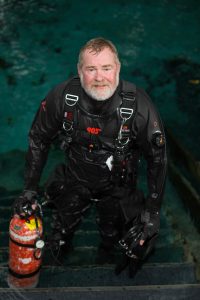Lamar started diving in 1979 after moving to Jacksonville, FL. The springs of North Florida were the closest dive sites to Jacksonville that did not require getting on a boat. After diving all of the springs countless times, he was naturally drawn to the caves. He earned his NAUI open water instructor rating in August 1984. And in November 1984, after cave diving for five years and logging over 1000 dives, he earned his cave instructor rating with the NSS-CDS.
He has gone on to explore and map many cave systems in North Florida and around the world with a small group of dive buddies. The motivation to explore and challenge himself led to the design of many new Dive Rite products and diving styles. Lamar was one of the first to use sidemount techniques to push caves beyond the range of back mounted cylinders. In 1985 he used this knowledge and experience to write the first sidemount specialty program for cave divers for the NSS-CDS.
He has tested gear and explored caves and wrecks around the world, including caves/mines in Finland, Puerto Rico, Dominican Republic, Australia, Japan, Italy, Russia, and numerous sites in the USA.
Lamar is passionate about cave rescue and recovery. He has traveled around the world for the International Cave Rescue/Recovery team, training divers for this specialty, including Australian and Italian teams.
Lamar is still a very active instructor. He has trained more than 650 people to cave dive since 1984, and continues to train rebreather, sidemount, cave, and other technical divers.
Lamar continues to actively dive in caves and wrecks around the world. This provides the inspiration for developing and improving the Dive Rite product line by testing it in any environment imaginable.
How and why do you use checklists?
Checklists have been a part of my diving routine for years. Cave diving especially calls for the use of checklists. I have a mental checklist I work through as soon as I get to the dive site, pulling each piece of equipment needed for the dive and placing it on the tailgate of my truck. Before I head to the water the tailgate must be clear to close, ensuring I have got everything with me. There is nothing more embarrassing than the trek back to the truck for something you left behind. Once in the water we do a head-to-toe check with our buddies to double check that we have everything and so do our buddies.
When I started CCR diving it became obvious that the use of checklists is imperative. Most early incidents that I had heard of were caused by assembly error or not checking the full function of the unit before jumping in the water. An assembly checklist as well as a pre-splash checklist are required.
A proper assembly checklist alerts you to problems that you may miss otherwise. Checks like ensuring the millivolt readings of sensors are in range or that batteries have sufficient life left can easily be overlooked or forgotten about without a prompt.

